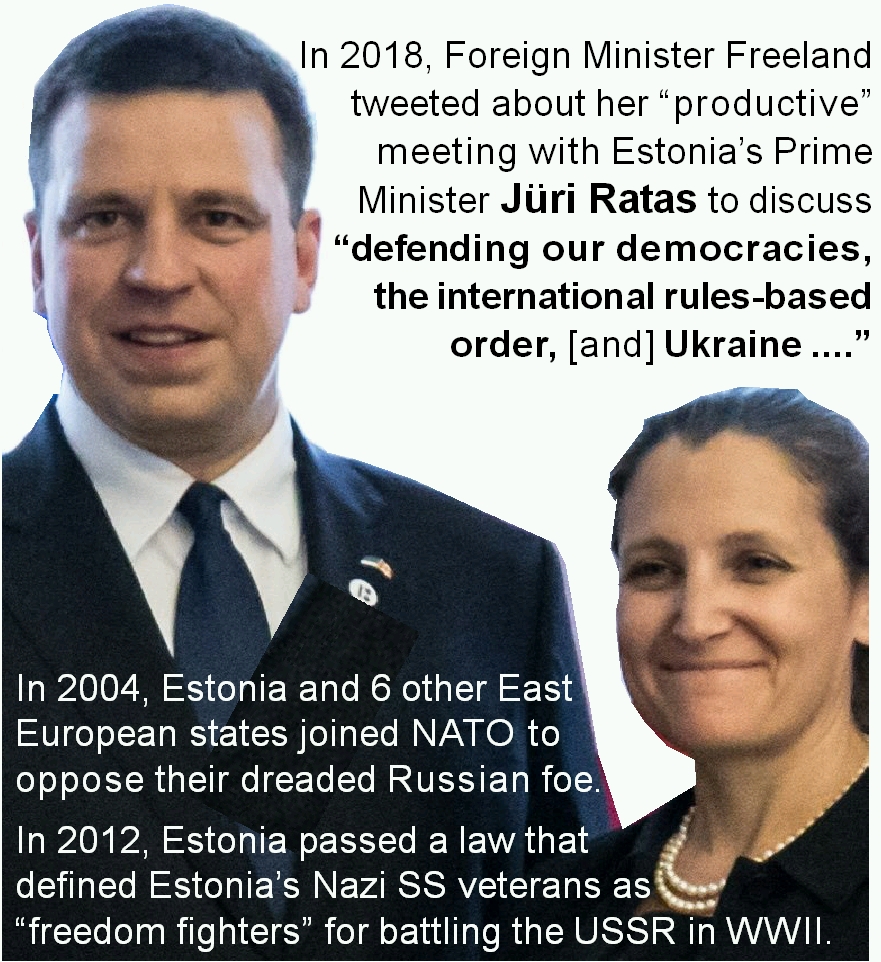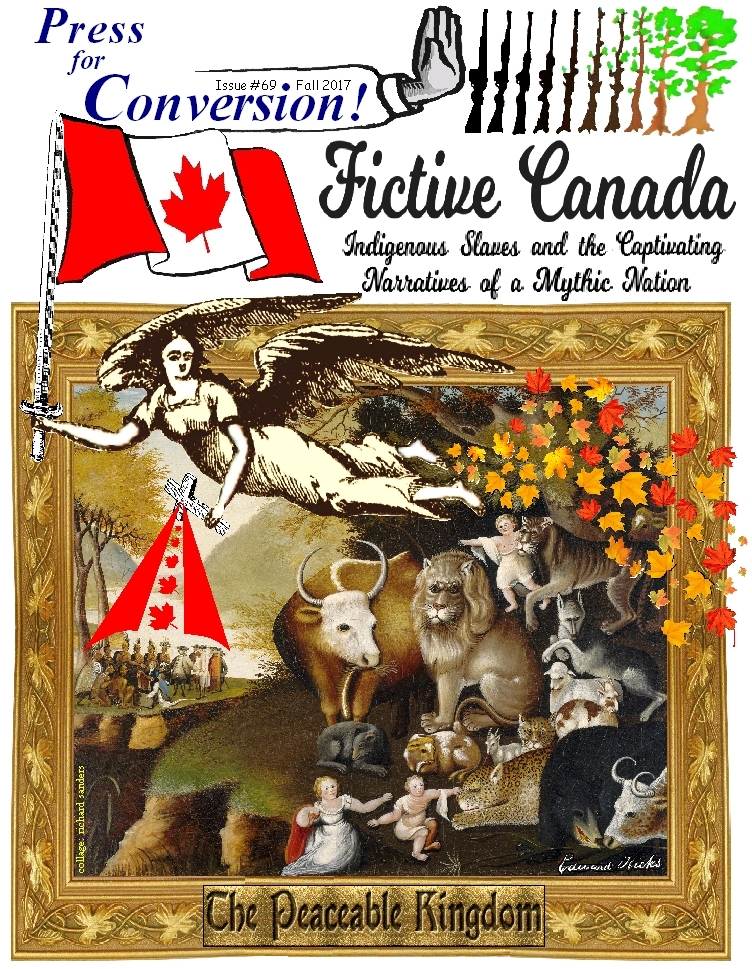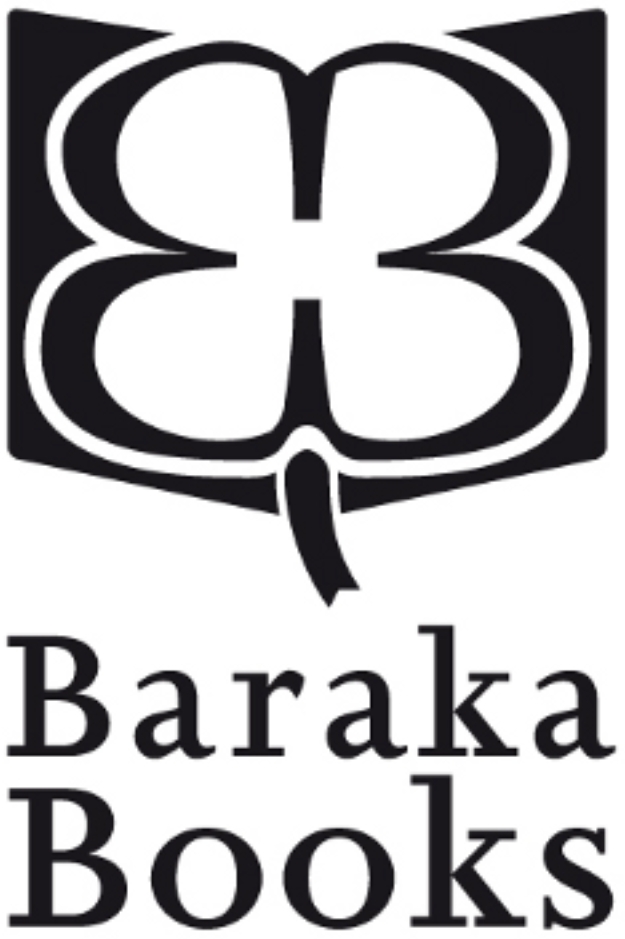|
In describing its Cold-War efforts,
the ECC has said "it was easy to find allies amongst Western governments,
politicians and media."5 This remains the case. The ECC still enjoys the same
powerful allies that it enjoyed throughout the Cold War. For example, the ECC
says it has "fought to further
Magnitsky sanctions in Canada,...
maintained support for NATO, ... [and] for Ukraine in their war with Russia."
The ECC has also been very active in the
Black Ribbon Day movement. It was
founded in the 1980s by Markus Hess, who became the ECC’s president (2011-15).
He now represents the ECC on the board of
Tribute to Liberty (TTL). It
won unanimous support from parliament to fund a large monument in Ottawa
dedicated to promoting anticommunism.6
ECC links to Nazi collaborators
In the early 1960s, the Soviet Union publicly
exposed various ECC activists and leaders who it identified as Nazi
collaborators. One 1964 article, in a Soviet Estonian publication for émigrés
called Homeland, said:
The Canadian emigrees’ "Estonian Central
Council," is justifiably called a "Sonderkomando" ([CIA] Translator: Special
activities group in German such as execution detachments, etc.) Its membership
included ... Aksel Luitsalu and Aleksander Laak. 7
The Soviets also named other
Nazi-linked ECC leaders: former SS-lieutenants Ilmar Heinsoo, Eerick Heine and
Lino Kurist; former SS-Legion staff member Harri Parkma; and former Gestapo
police commissioners Samuel Kook and August Kala.8
Winnipeg’s Aleksander Laak: Commandant of a Nazi death camp
 Using Nazi files, eye-witness
accounts and other evidence gathered when liberating Estonia from German
occupation in 1944, the Soviets identified Aleksander Laak as the most brutal of
Estonia’s Nazi collaborators in Canada. According to files available through the
US Holocaust Memorial Museum, the Soviets indicted Laak on August 20, 1960, for
"organizing extermination camp Jägala and personally shooting Jews."9 Using Nazi files, eye-witness
accounts and other evidence gathered when liberating Estonia from German
occupation in 1944, the Soviets identified Aleksander Laak as the most brutal of
Estonia’s Nazi collaborators in Canada. According to files available through the
US Holocaust Memorial Museum, the Soviets indicted Laak on August 20, 1960, for
"organizing extermination camp Jägala and personally shooting Jews."9
A
week later the USSR’s Tass News Agency reported that the former commandant of
this Estonian death camp, who oversaw the murder of 3,000 prisoners, had been
living in Winnipeg since 1948. Within six days, over 30 Canadian newspaper
articles mentioned the Tass report, but not one was interested in pursuing the
truth or falsehood of the Soviet statements.10 Instead, most said that what they
called the "Red Story," "Red Charges" or "Red Claims" were mere "propaganda."
This spin was aided by the RCMP. Most of Canada’s news articles quoted an RCMP
officer who denigrated the Tass report as "a piece of propaganda." Many added
that after talking to Laak, "the RCMP appears satisfied he has a clear
record."11
|

Despite all the evidence, and more than three
dozen witnesses that testified at the Soviet trial in 1960,
Canadian corporate media insisted on describing Laak
as an "alleged Nazi war criminal," even in 1990.
Red
Deer Advocate, April 17, 1990, p.2. |
The RCMP showed its bias by
harassing Keith Rutherford, a young Winnipeg reporter who dared broadcast Moscow
Radio’s report on Laak. The RCMP "wanted to know why I sent to Moscow for the
tape," said Rutherford. "I guess they thought I was a Communist in disguise."12
Mounties grilled him on his links to a leftwing CCF youth group, his mother’s
turn-of-the-century labour actions and his brother’s teacher, a WWII pacifist.13
(Thirty years later, in April 1990, a gang of swastika-wearing skinheads shouting ‘White Power’
attacked Rutherford to avenge his 1960 program and left him blind in one eye.
One of them, who pretended to be Laak’s grandson, received a mere six-week jail
term.14)
In contrast to Rutherford, corporate journalists
like Southam’s Charles King presented the government line. Writing from Ottawa
about government reactions to Soviet news reports on Laak, King assured readers
in 1960 that "the experts here believe it is probably a phony."15
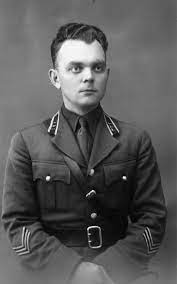 |
|
Aleksander Laak, 1942 |
Laak, still unnamed by Canada’s
mainstream press, came forward to proclaim innocence. Laak admitted he was a
WWII veteran who had fought the Soviets and that he had commanded Estonia’s
central prison. Saying he knew the Soviets were pursuing him for crimes, he
insisted that he had never heard of the Jägala death camp. "The Russian story is
99 per cent lies," he claimed. "It is only Communist propaganda." His son,
scolding Canada’s media, demanded: "Why should you print that Communist
propaganda?" Newspapers, he insisted, "are just letting themselves be used" by
the Soviets, who "just wanted my father to be pestered."16 Comments by Laak’s
wife, neighbours, co-workers and employer at Winnipeg’s Air Force base, were
used to reinforce Laak’s story that he was a victim of Soviet lies.
After this initial flurry, media
stories stopped. Three days later, the frenzy reignited when Laak killed
himself.17 Newspapers divulged his name and began spreading their verdict that
Soviet propaganda had pushed this innocent man to suicide. A death notice in the
Estonian war veterans’ publication, Võitleja (Combatant),
memorialized Laak as a "victim of communism."18 Four city papers said "Fear of
communism aroused by Communist propaganda was blamed today for the death of a
53-year-old Estonian who hanged himself..."19 Eight headlines that day falsely
claimed that Canada’s government had cleared Laak of all charges.20
The ECC defends Laak’s innocence

Enn Salurand
| After finding safe haven in
Canada, Salurand helped found the Estonian Central Council in Canada and
was its secretary general for more than 25 years. He was revered as a
veteran of Estonia’s "War of Independence" against Soviet Russia
(1918-20). In 1931, he helped create and lead the Estonian National
Club (EKN) in Estonia, and was editorial chief of its journal in 1935. The EKN was
an elitist, anti-democratic organization whose radical-right
ethnonationalist policies were eugenics-based and intolerant of national
minorities. The EKN was banned in 1940 when the
Soviets took power in Estonia. In 1960, when the Soviets exposed the fact
that Winnipeg's Alexander Laak was the commander of Estonia's Jägala
death camp, Salurand called it a Communist propaganda
attack designed to target and discredit all Estonians. |
|
The ECC then took to the media
battlefield. One article, "Estonians Fear Smear Campaign," said Toronto’s 8,000
Estonians were afraid they would "come under a Soviet propaganda barrage of the
kind" that "drove a former Estonian in Winnipeg to commit suicide." Then-ECC
leader, Enn Salurand, told the press that Estonian Canadians were "bracing
themselves for a Communist campaign designed to discredit them" and that it "is
very easy for the Reds to make up all kinds of lies about innocent persons."21
Salurand, the ECC’s secretary
general for more than 25 years, was a veteran of Estonia’s "War of Independence"
against Soviet Russia (1918-20).22 In 1931 he helped create and lead the
Estonian National Club (EKN) and was editorial chief of its journal in 1935. The
EKN was a "group of ultranationalist intellectuals, whose publication," says
scholar Pin-Yu Chen, was "the platform of radical right ideologies." Chen, whose
PhD thesis includes ERK’s eugenics-based ethnonationalism, notes that the
"EKN’s strong vision of the nation
as a biological entity, threatened by degeneration and diseases, was behind
their intolerance of national minorities, anxiety of assimilation and
miscegenation, elitist and anti-democratic politics."23
When the Soviets took power in 1940
Estonia, they outlawed the EKN. After coming to Canada in 1950, Salurand helped
found the ECC, and is said to have never missed a board meeting of Võitleja.24
"[T]he Soviet attack against Laak,"
said Salurand, "is just the beginning of a new war of nerves against all of
us."25 All too many Estonian Canadians were very nervous about being the next
"target of a Russian news agency attack" because — like Laak — they too had
collaborated with the Nazis against their shared enemy, the USSR. "[W]hoever was
in the [Nazi-led] army during the occupation ... could be singled out next,"
said one Estonian émigré. "The Russians," he continued, "could easily say that
Mr. X ... was a captain in an army unit which committed atrocities in
Estonia."26
The next day, Sept. 10, 1960, a Regina
editorial went further. Capitalizing on Laak’s suicide, it spread Cold-War
anti-Red hysteria to nonEstonian Canadians:
All too many Canadians have been prone to
look upon the post-war, east-west struggle in terms of newspaper headlines
that can have little or no effect on their private lives. The tendency has
been to view the cold war as ... far from the daily rounds of the average
Canadian communities. ... [But] the battle against totalitarianism is real.
This was brought home last week when the long arm of international communism
reached into a prairie city to claim another victim. Alex Laak... He had been
cleared by the Canadian immigration department and the RCMP. But the
clearances were not enough ... he took his life, according to some reports to
protect his friends and family.... The fact that Estonians living in Winnipeg
are reported afraid that they...may be next on the Communist list will bring
home to Canadians that...they too are in the battle line. 27
Jewish women and 40 others identify Laak as death camp leader
Some Canadians, including a Jewish
Holocaust survivor in Toronto, did not appreciate the press telling them that
Laak was an innocent victim of communism. Czech refugee Greta Zarkower, a
survivor of the Jägala concentration camp, had seen Laak in 1942. After
recognising his photo in the news, she and other former slave labourers at his
prison camp called the media. "Laak was wearing the SS uniform and was in
charge," recalled Zarkower. "Laak and his men took all our valuables"28 and "I
was beaten unmercifully, regularly, with a riding whip by SS men."29
Two other Holocaust survivors also
contacted the Canadian Press after recognizing Laak’s face in papers. They too
confirmed seeing him when he was Jägala’s commandant. These US citizens, Gizela
Herzl and Susan Spalter, were among the Czech and German Jews that the Nazis
trucked to Laak’s camp on Sept. 5, 1942. Most, including their closest loved
ones, were killed there that day. In late 1943, Herzl and Spalter were moved to
Estonia’s state prison where Laak became chief warden.30
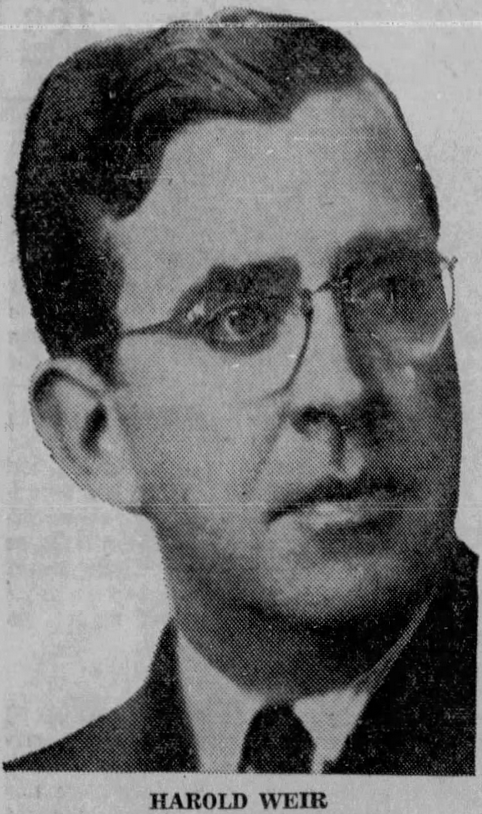
|
Damning "Red Russia" and its "meddlesome and presumptuous bigots" who
wanted "to have a blood-dripping finger in the Canadian pie," columnist
Harold Weir ended his Red-baiting rant by slamming the infantile idea of
"Canadian neutrality":
When the Communists ... have the gall to
virtually sentence our residents to death, it seems to become crystal clear
that any dream of Canadian neutrality is so much marijuana smoke, reminiscent
of the mewling of colicky infants. (Emphasis added.) ("Neutrality
Out,"
Vancouver Sun, Sep. 21, 1960, p.4.)
Ironically, Canada’s press then went quiet on
the Laak story until seven months later when a Soviet court heard
confessions about his key role in slaughtering crying infants that were "as
young as a year old." |
|
Vancouver Sun columnist Harold Weir
summed up the news with slurs about "parlor pinks," "fellow travelers" and
"easy-bleeders." Claiming "the Reds reached out from Russia and put the finger"
on Laak, Weir said Canadians "should not be picked off by long-range snipers
from Moscow." Damning "Red Russia" and its "meddlesome and presumptuous bigots"
who wanted "to have a blood-dripping finger in the Canadian pie," Weir ended his
Red-baiting rant by slamming the infantile idea of "Canadian neutrality":
When the Communists ... have the gall to
virtually sentence our residents to death, it seems to become crystal clear
that any dream of Canadian neutrality is so much marijuana smoke, reminiscent
of the mewling of colicky infants. 31
(Emphasis added.)
Ironically, Canada’s press went quiet on Laak
until seven months later when a Soviet court heard confessions about his key
role in slaughtering crying infants "as young as a year old." Ralph Gerrets, who
Laak had made his deputy at Jägala, confessed that they killed thousands of
prisoners, mostly Jews and "Gypsies." Describing in gruesome detail one of their
many massacres, Gerrets told the court they were aged only:
three to five years, barefoot, hatless,
dressed in pyjamas, icy cold and all crying.... I took those by the hand and
led them to the trench...where they were shot. 32
The murderers, he testified, included Laak.
Another Estonian who pled guilty to these
murders was Jan Vijk. He and Gerrets identified Laak as "the principal killer."
Gerrets also described the mass execution of 900 foreign Jews brought to Jägala
on September 5, 1942. 33 Vijk, Gerrets
"and two score [i.e., forty] other witnesses indicated he [Laak]
was the most bloodthirsty of the Estonian police force."34 (Emphasis added.)
Soviet courts amassed overwhelming evidence
against a third accused, Ain-Ervin Mere, commander of Nazi Estonia’s Security
Police. Mere was tried in absentia because Britain refused to extradite him. If
Laak had lived, Canada too would certainly have rejected Soviet extradition
requests.
Soviet courts heard disturbing testimony from
Jägala’s female prisoners. They described being "ordered to undress on arrival
at the extermination camp while they were being examined by Gerrets and Lt.
Alexander Laak." 35 Witnesses testified
that "girl inmates...were forced to take part in orgies at night and murdered
afterward."36 Mere and Laak arranged these "drunken orgies" during Mere’s visits
to Jägala.37
|
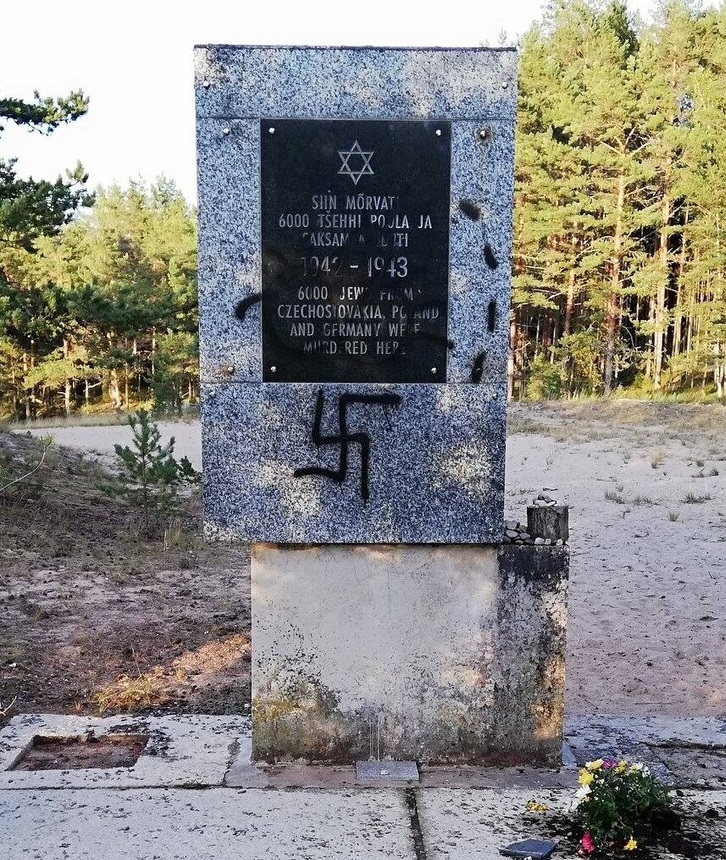
This memorial at the
execution site for the Jägala concentration camp was erected in 1960 in
Soviet Estonia. It was desecrated in August 2018.
|
Despite such shocking evidence,
including 40 witnesses who identified Laak as the camp’s murderous leader, no
Canadian newspapers mentioned Laak, or previous claims of his innocence by the ECC, RCMP, the government and media. Instead, most stories critiqued the trial
by saying its "major purpose" "was to bring discredit upon the Estonian emigre
organizations."38 When the three Estonians were sentenced to death, Canadian
papers did not mention Laak. Rather, most concluded that the "six-day show trial
apparently aimed at discrediting anti-Soviet Estonian refugee groups."39
The only media response from Canada’s
Estonian community was a letter to the editor from the ECC-linked Estonian
Society of Montreal. Its vice president, Martin Puhvel, castigated the
Gazette’s coverage of the trial and defended Estonia’s Nazi collaborators as
"patriots" who fought "unprovoked aggression by the Russian enslavers":
"[I]t is incomprehensible how any paper
could dignify such vicious propagandists fairytales by reporting them ... on
its front page under a blaring headline ‘Nazi firing squad shot children.’ The
Soviet propaganda machine has ... launched a campaign of calumny and
vilification against Estonian patriots whose only ‘crime’ lies in defending
their homes against murderous, unprovoked aggression by the Russian enslavers
.... "40
Calling it all a "vicious smear
campaign," Puhvel blamed the media for giving "help and comfort to the enemies
of freedom" by "spreading grisly, painful stories of massacre of infant children
by men who were busy defending their homes" against the Reds.41
Waffen SS officer Aksel Luitsalu,
a prominent leader of the ECC,
met both Pearson and Diefenbaker
After
the trial, the Soviets reported that on Aug. 5, 1960 Prime Minister
John
Diefenbaker
had met Nazi collaborator and ECC leader, Aksel Luitsalu, the wartime police
chief of Tartu, Estonia’s second largest city. Tass said "investigating agencies
on crimes committed in Estonia during the Nazi occupation" found that "14,000
were murdered in Tartu during the Nazi occupation, including a large number of
children aged six to 12."42
Luitsalu admitted he "served on the
Tartu police force from 1933 to 1944" and "rose to the rank of commissar," but
denied any wrongdoing in Nazi Estonia.43 After becoming Tartu’s police chief in
1942 he was a company commander in Estonia’s Waffen SS. With the Nazi SS rank of
Obersturmführer (Senior Lieutenant), Luitsalu fought the Soviets on the
Eastern Front. Following his time in a British POW camp (1945-46), he was active
in Germany’s Estonian community before moving to Canada in 1951.44
Luitsalu denied all charges as a
"Pure lie from the very beginning."45 His comments never critiqued the Nazis but
always attacked the Soviets. "The charges" against him, he said, "are typical
Russia smear tactics aimed at covering their own sins."46 The Soviets, papers
claimed, sought "to disgrace leaders of foreign communities in all cities in the
free world." In this context, Luitsalu "recalled the recent suicide of a
Winnipeg immigrant, Alex Laak, similarly charged and ‘hounded to death’ by the
Russians."47
|
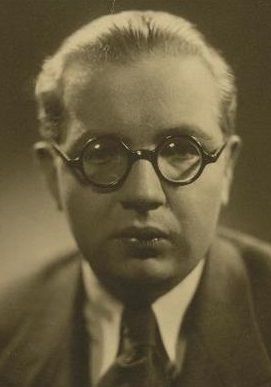
Endel Kareda
This Untersturmführer (2nd Lieutenant) in Estonia’s Waffen SS in
1944, came to Canada and became the founding editor of an Estonian
weekly. In 1961, to
counter Soviet revelations about Estonian Canadians (like Axel Luitsalu,
who collaborated with the Nazis), the Estonian Central Council
published Kareda's book Estonia: Forgotten Nation. |
The "ECC took the necessary steps to
counter the attacks on A. Luitsalu," who was their vice president. In the 1950s
Luitsalu had led
the Toronto Estonian Society48 and the Baltic Federation in Canada (BFC).49 To
decry the Soviet’s so-called "savage campaign against the Canadian prime
minister and Estonian refugees," the ECC began a "counter campaign." This
included ECC media outreach, government briefs and the publication of Estonia: Forgotten Nation."50
This ECC book was penned by Endel Kareda,
who had been the founding editor of a Toronto-based Estonian
weekly, Meie Elu (Our
Life). Kareda, a German Estonian, whose family name had been changed from
Klaussen, was an Untersturmführer (2nd Lieutenant) in Estonia’s
Waffen SS in
1944.51
While Diefenbaker "declined comment
on [Soviet] charges" that Luitsalu "was a Nazi collaborator,"52 Liberal
Party leader Lester
Pearson
belittled the Soviet report by smearing it as communist propaganda. Pearson, who
had helped lead Canada’s anti-Red war of words for a decade, quickly joined the
Soviet bashing. "I detest smears,"53 said Pearson, without any sense of irony.
Luitsalu met John Diefenbaker during the BFC’s August-5 delegation to Ottawa. Its president, Jonas Simanavicius, was a
leader of the
Lithuanian Canadian Community.54 He had also led a BFC delegation in June when Luitsalu and others met Pearson,55
who was then leader of Canada's official opposition. The BFC was lobbying for Canada to use its UN platform to rebuke the
USSR.56 Diefenbaker’s stridently antiSoviet speech at the UN that September57 is
still fondly recalled by Estonian nationalists.58 Joining the ECC in
cheerleading Diefenbaker’s diatribe was that network of former Nazi
collaborators, the
Anti-Bolshevik Bloc of Nations.
 References and notes References and notes
1. Ülle Kraft, Year 1941 in
Estonia, (Estonian War Museum), 2007, p.237.
http://bit.ly/Kraft-1941
2. Affidavit of Karl Eerme, Dec.18, 1964.
http://bit.ly/CIA-Eerme
3. Karl Eerme, Days without Days and
Nights Without Nights, 1962-63. (Note: These memoirs of Nazi Estonian army
and a US POW in Germany.)
http://bit.ly/EermeMemoirs
4. Linda Blanshay, The Nationalisation
of Ethnicity: A Study of the Proliferation of National Mono-Ethnocultural
Umbrella Organisations in Canada, 2001, p. 206-07. (PhD thesis, Sociology,
Univ. Glasgow).
http://bit.ly/BlanshayPhD
5. ECC elections, Mar. 23, 2007.
http://bit.ly/ECCelect
6. Markus Hess, "Vote!," Estonian Life,
Dec. 5, 2015. http://bit.ly/VoteHess
7. Excerpt, CIA translation, "About an
Angel with Pink Wings," Homeland, May 27, 1964.
http://bit.ly/CIA-ECC
8. Ibid.
9. Finding aid, US Holocaust Memorial
Museum for Estonian State Archives of the former Estonian State Security
Cttee’s records on war crime investigations and trials in Estonia, p.28.
http://bit.ly/USHMM-Estonia
10. See author’s collection of articles,
Aug.29-Sep.2, 1960.
http://bit.ly/NewsLaak1
11. "Family of Alleged Nazi tells of Early
Struggles, RCMP appears Satisfied...," Star-Phoenix, Aug.31, 1960, p.1.
http://bit.ly/SP_8-31-60
12. "Beaten man not cowed by intimidation,"
Edmonton Journal, Apr.17, 1990, p.3.
http://bit.ly/EJ-90
13. Warren Kinsella, Web of Hate: Inside
Canada’s Far Right Network, 1994, pp.180-81.
14. Ibid., p.183-84.
15. Charles King, "Nazi torturer in
Winnipeg? Ottawa thinks story ‘phony’," Province, Aug. 30, 1960, p.26.
http://bit.ly/VP_8-30-60
16. See author’s collection of ten
articles, Aug.31-Sep.7, 1960.
http://bit.ly/NewsLaak2
17. See author’s collection of sixteen
articles, Sep. 7, 1960.
http://bit.ly/NewsLaak3
18. Võitleja (Combatant or
Fighter),
Oct. 1960, p.8.
In 1980, this "Global Voice of Estonian
Military and Freedom Fighters," founded by veterans who fled to Nazi Germany
in 1944, moved to the ECC’s Estonian House, Toronto.
(The publication's masthead uses the symbol of the Estonian Waffen SS.)

19. For example, "Laak Suicide Blamed on
Fear of Communist Propaganda," Star-Phoenix, Sep.8, 1960, p.9. See also
author’s collection of articles, Sep.8, 1960.
http://bit.ly/NewsLaak4
20. Headlines include: "No Evidence he was
War Criminal: Probe Clears ‘Nazi’ Suicide Victim," "Laak Cleared in Check,"
"Ottawa Investigations Clear Man accused by Russians," "Records give Laak
Clean Bill." These absolved the government for letting Laak into Canada
because he had not divulged (or had not been asked) anything to incriminate
him.
See author’s collection of eight articles,
Sep. 8, 1960. http://bit.ly/NewsLaak5
21. "Estonians Fear Smear Campaign,"
Ottawa Journal, Sep.9, 1960, p.24.
http://bit.ly/OJ_9-9-1960
22. Võitleja, Mar/Apr 1992, p.10.
http://bit.ly/Voit2-92
23. Pin-Yu Paris Chen, Race, Nation, and
Eugenics in Interwar Estonian Radical Right Journal ERK Magazine, 2017,
p.4. (MA, U. of Tartu, Political Studies.)
http://bit.ly/ChenPhd
24. Võitleja, Mar./Apr. 1992,
ibid.
25. "Estonians here fear Red ‘Hate’
campaign," Ottawa Citizen, Sep.10, 1960, p.10.
http://bit.ly/OC-9-10-1960
26. "Estonians Fearful Relatives in Canada
May Become Targets," Edmonton Journal, Sep. 9, 1960, p.30.
http://bit.ly/EJ_9-9-1960
27. Editorial, "Another cold war casualty,"
Leader-Post, Sep. 10, 1960, p.15. (The L-P's editor was Percy G.
Keffer.)
http://bit.ly/LP_9-10-1960
28. "Woman in East knew hanged Nazi,"
Vancouver Sun, Sep.12, 1960, p.3.
http://bit.ly/VS91260
29. "Laak Took Valuables Toronto Woman
Says," Red Deer Advocate, Sep.12, 1960, p.10.
http://bit.ly/RDA_9-12-1960
30. See author’s collection of fifteen
articles, Sep.10-13, 1960.
http://bit.ly/NewsLaak6
31. Harold Weir, "Neutrality Out,"
Vancouver Sun, Sep. 21, 1960, p.4.
http://bit.ly/VS_9-21-1960
32. "Children’s Slaughter Described,"
Leader-Post, Mar. 7, 1961, p.28.
http://bit.ly/LP_3-7-1961
33. Preston Grover, "Led Tearful Children
to Nazi Firing Squad," Ottawa Journal, Mar. 7, 1961, p.14.
http://bit.ly/OJ_3-7-1961
See author’s collection of
seventeen articles, Mar.6-8, 1961.
http://bit.ly/NewsLaak7
"Estonian policemen stand trial for war
crimes." (Soviet film from the trial includes Gerrets’ testimony that Laak
shot children.)
http://bit.ly/USHMM-film
34. "Estonian Court Decrees 3 to Die; Laak
Most Bloodthirsty," Windsor Star, Mar.13, 1961, p.12.
http://bit.ly/WS_3-13-1961
35. "Jewish Women Tell of Horror while
Parents Exterminated," Montreal Gazette, Mar. 8, 1961, p.4.
http://bit.ly/MG_3-8-1961
36. "Girls Forced into Orgies, then Slain,
Court told," Ottawa Citizen, Mar. 8, 1961. p.7.
See author’s collection of seven articles,
Mar. 8, 1961. http://bit.ly/NewsLaak8
37. Current Digest of the Soviet Press,
Vol.12, 1960, p.41.
http://bit.ly/SovietPress1960
38. See author’s collection of nine
articles, Mar. 9-13, 1961.
http://bit.ly/NewsLaak9
39. See author’s collection of eight
articles, Mar. 30-Apr.6, 1961.
http://bit.ly/NewsLaak10
40. "Protests Story of Estonian ‘Trial’,"
Montreal Gazette, Mar.13, 1961, p.6.
http://bit.ly/MG3-13-61
41. Ibid.
42. "Diefenbaker Saw Him: Soviets ‘Expose’
Estonia Emigre," Times Colonist, Nov. 14, 1960, p.3.
http://bit.ly/TC_11-14-1960
43. "Red Charge denied...," Vancouver
Sun, Nov.14, 1960, p.14.
http://bit.ly/VS11-14-60
44. Taivo Kirm, "When a Kaagvere man in
Toronto fought for Estonian freedom," Kastre Valla Infoleht, Jun. 1,
2018, p.8. (translation)
http://bit.ly/KVI_6-1-2018
45. See author’s collection of 11 articles,
Nov.14-15, 1960. http://bit.ly/NewsLaak11
46. "Estonian Leader Denies Red Charge,"
Ottawa Journal, Nov. 14, 1960, p.21.
http://bit.ly/OJ_11-14-1960
47. "Red Charge Denied ..."
op. cit.
See author’s collection of nine articles,
Nov. 14-15, 1960
http://bit.ly/NewsLaak12
48. Aksel/Axel Alexander Luitsalu
http://bit.ly/GenLuit
49. Red Deer Advocate, Nov. 14,
1960, p.1.
http://bit.ly/RDA_12-14-1961
50. The Estonians in Canada, Vol. I,
1975.
http://www.eesti.ca/ajalugu/en/ec.html
51. Names, National Archives of Estonia
http://bit.ly/EstArchives
52. Star-Phoenix, Nov. 14, 1960,
p.1. http://bit.ly/SP_12-14-1960
53. "Pearson Hits Reds for Smear Tactics,"
Edmonton Journal, Nov. 16, 1960, p.53.
"Pearson Hits Propaganda and Smears,"
Province, Nov. 16, 1960, p.5.
http://bit.ly/PearLuit
54. Ibid.
(Note: Simanavicius was BFC
president (1957, 1960-61), president of Toronto’s LCC and on the LCC executive
(1974-80).
Fonds 14, Jonas Robertas Simanavicius fonds
http://bit.ly/Simanavicius
55. Ibid.
56. "Reds Say Refugee was Mass Slayer,"
Ottawa Citizen, Nov. 14, 1960, p.7.
http://bit.ly/OC_12-14-1960
57. UN General Assembly, Plenary, Sep. 26,
1960, pp.108-12.
http://undocs.org/en/A/PV.871
58. Kirm, op. cit.
|

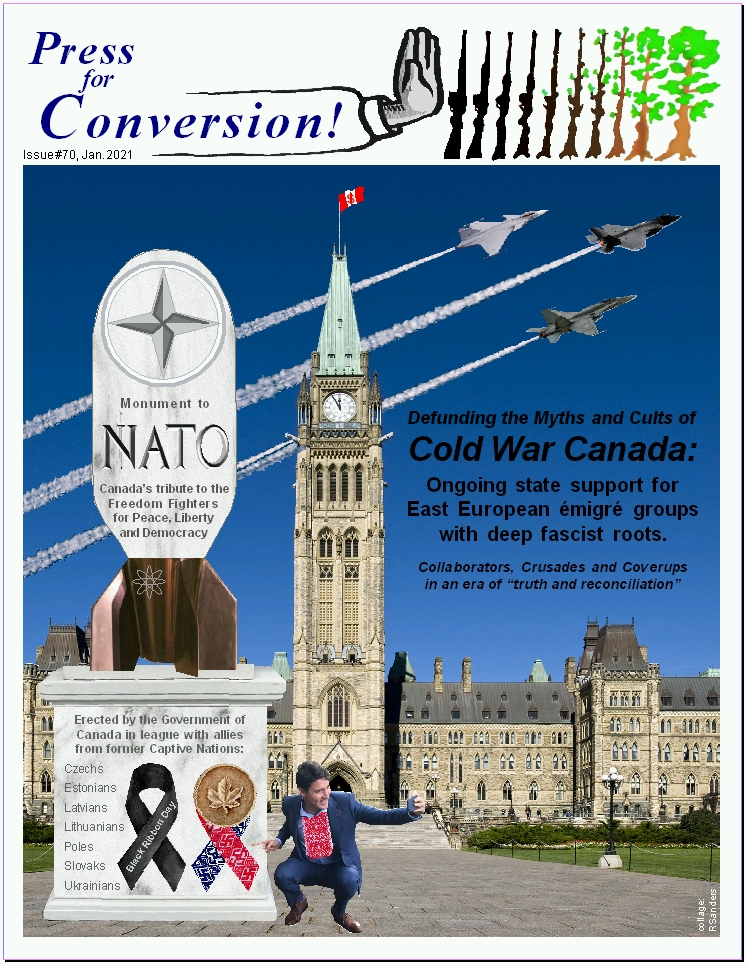
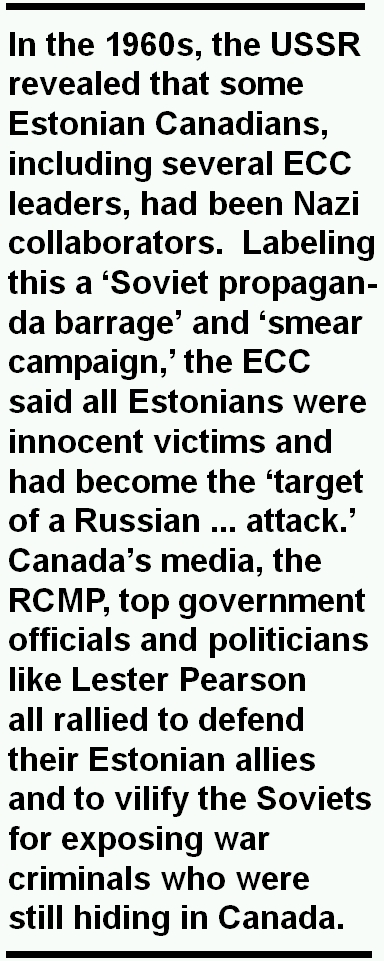 The
Estonian Central Council (ECC) in Canada claims to oppose both Nazism and
communism, which it equates as twin evils. However, since its creation in 1954,
ECC efforts have focused entirely on battling communism. This, after all, was
the fixation of various Waffen SS veterans and Gestapo members, and other Nazi collaborators and their apologists who
formed and then led the ECC
throughout the Cold War.
The
Estonian Central Council (ECC) in Canada claims to oppose both Nazism and
communism, which it equates as twin evils. However, since its creation in 1954,
ECC efforts have focused entirely on battling communism. This, after all, was
the fixation of various Waffen SS veterans and Gestapo members, and other Nazi collaborators and their apologists who
formed and then led the ECC
throughout the Cold War.
 Using Nazi files, eye-witness
accounts and other evidence gathered when liberating Estonia from German
occupation in 1944, the Soviets identified Aleksander Laak as the most brutal of
Estonia’s Nazi collaborators in Canada. According to files available through the
US Holocaust Memorial Museum, the Soviets indicted Laak on August 20, 1960, for
"organizing extermination camp Jägala and personally shooting Jews."9
Using Nazi files, eye-witness
accounts and other evidence gathered when liberating Estonia from German
occupation in 1944, the Soviets identified Aleksander Laak as the most brutal of
Estonia’s Nazi collaborators in Canada. According to files available through the
US Holocaust Memorial Museum, the Soviets indicted Laak on August 20, 1960, for
"organizing extermination camp Jägala and personally shooting Jews."9






 References and notes
References and notes
